|
May 1946 Popular Science
 [Table of Contents] [Table of Contents]
Wax nostalgic about and learn from the history of early
electronics. See articles from
Popular
Science, published 1872-2021. All copyrights hereby acknowledged.
|
May 1946, when this Atomic Medicine
article appeared in Popular Science magazine, was less than a year since the atomic
bombs that ended World War II were dropped on Hiroshima and Nagasaki, Japan.
The Manhattan Project, codename for the U.S. effort that led to both the fission
(Hiroshima) and fusion (Nagasaki) bombs, was necessarily shrouded in secrecy in
order to assure that Germany's
Uranverein work (Japan was not developing an atomic bomb) did not benefit from
America's success. Once the horrific destructive power and effects of radiation
exposure were witnessed by the world, even more importance was placed on keeping
the lid on nuclear technology. During the post-war era, getting information on radio
and radar advancements, material science, aircraft and rocket propulsions and aerodynamics,
emergency medical devices and formulations, and other realms of high technology
was difficult, but the government would divulge almost nothing on nuclear research.
The media collectively had fits over it all, claiming the public that sacrificed
life, limb, and fortune had a right to access and benefit from at least some of
the information. The editor of Popular Science published a full−page op−ed
(see below) to that regard in this issue as the result of attempting to collect
data for this article.
Atomic Medicine
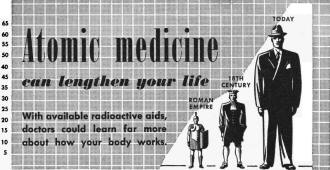
With available radioactive aids, doctors could learn far more
about how your body works.
By Carl Dreher
Man has more than doubled his life span since Roman times. Atomic medicine now
promises to stretch it farther.
In 1912 Dr. Georg von Hevesy, a young Danish scientist, was at Rutherford's laboratory
in London, experimenting with radiation and radioactive atoms. Hevesy was a bachelor
and lived at a boarding house, where the meals aroused his suspicions. One Sunday
he left a little radioactive lead with the remainder of his meat.
Thereafter, every day that week, he took a sample of the meat that was served
to him back to his laboratory, and on each day he found it contained a trace of
radioactive lead!1
This was probably the first application of tracer technique in biology, a method
that now seems destined to clear up many of the obscurities that handicap physicians.
Therapy will follow as the atomic bomb followed knowledge and necessity. Tracer
research, in short, means that many of us will have a chance to live longer, happier,
more productive lives.
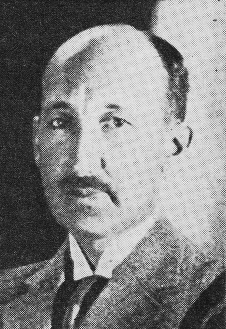
Dr. Georg von Hevesy's doubt about his hash made history.
The radioactive lead that Hevesy used in 1912 was radium-D, an intermediate product
of the spontaneous disintegration of radium, which meant that there wasn't much
of it. Moreover, it was poisonous and hence unsuitable for experimentation on living
animals except in very minute quantities. But now practically all the elements,
including the common organic components such as carbon, nitrogen, phosphorous, sodium,
iodine, and hydrogen can be made radioactive. So medical researchers really have
something to work with.
These materials are produced by taking a common element, such as red phosphorus,
and bombarding it in a cyclotron, an electro-static generator, or, now, in a uranium
pile. Thereupon a radioactive isotope is produced. An isotope is a form of an element
that differs in atomic weight from the original, because something has been knocked
into or out of its nucleus, but does not differ in atomic number, or the surrounding
electrons that determine its electrical and chemical properties. Thus the common
phosphorus that is exposed to the action of the cyclotron is 15P31,
meaning it has 15 electrons revolving in its outer atomic space, and 31 heavy particles
in its nucleus. After bombardment with deuterons (heavy hydrogen particles that
are themselves isotopic) the phosphorus that emerges is 15P32:
each atom still contains 15 electrons, but the atomic weight has been raised from
31 to 32.
No chemist can distinguish P32 from P31 by the older chemical
methods, nor can the body tell them apart. But whereas P31 is stable,
P32 is radioactive - it emits beta particles, high-speed electrons. In
14.3 days half of these particles will be gone. That is the half-life of this material,
which nothing can alter. While it is emitting them, it can be detected wherever
it goes, in quantities defying the most refined chemical analysis.
A dynamic picture of what happens in a living plant, animal, or human body, when
the organism is functioning normally is thus obtainable. You don't have to overdose
it to get a detectable chemical response. The researcher has a tool a million or
more times as sensitive as the best quantitative chemical analysis. He can distinguish
between a substance previously present in the tissues, and the same substance newly
added-as Dr. Robley D. Evans puts it, between the atoms of phosphorus in the enamel
of a rat's teeth, which have been there for months, and the atoms of phosphorus
that the rat took in at its last meal. Such advantages, combined in a single technique,
make this development really momentous.
A number of instruments can be used for tracing and measurement. Photographic
emulsions, for example, are fogged by radiation. This property, by which Roentgen
discovered the X ray, is employed in the film badges worn by workers in the atomic-bomb
plants. Following processing of the film, the amount of darkening can be read on
a densitometer, giving the health authorities a record of the amount of radiation
received.
Film detection methods are very sensitive. They add up all the radiation received
during the entire exposure. But for precisely that reason they do not tell us what
happened during any particular part of that period. Specific measurements as of
a given time are made with the Geiger-Muller counter (PSM, Feb. '46, p. 121). Its
basic element is a glass tube filled with gas at reduced pressure and containing
a fine wire running lengthwise through a metallic cylinder. The wire is at a potential
of about +1,000 volts with respect to the cylinder. When the tube is placed over
the region to be studied the radiation passing into the space between wire and cylinder
produces ionization, or electrical conduction, by knocking electrons out of the
gas atoms. The result is a surge of current between the two electrodes. In this
indirect fashion the instrument acts as a sensitive chemical balance.

Workers on the Manhattan Project wore small ionization chambers,
shaped like fountain pens, in their pockets (below). Any decrease in their charge,
read on a special electroscope at the end of each day, showed how much ionization
(caused by radiation) had occurred since morning.
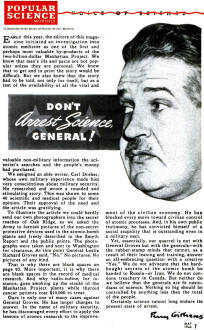
This is Page 7 - A statement by the editor of Popular Science
Monthly.
This sounds a great deal simpler than it is. Different sorts of radiation do
not pass into the ionization space with equal ease. The tube has to be shielded
as far as possible from all radiation other than that under observation. Correction
has to be made for stray radiation, such as cosmic rays, and the tube and its associated
amplifier must be kept in a constant state of sensitivity. The design and operation
of Geiger counters is thus a fine art in itself. This, in fact, is true of the whole
tracer technique and its applications. It represents an epoch-making development,
but one that requires the patience of a Job and the vigilance of an Argus. It is
a field for only the most devoted and highly trained scientists.
Not all isotopes are radioactive, and some stable, nonradioactive forms are fully
as useful in tracer work as the unstable forms. Heavy carbon, C13, is
one of these. Since carbon is the principal constituent of living matter, any special
form of it is of the utmost importance. Likewise for heavy hydrogen (H2)
and nitrogen (N15). These materials are traced by spectroscopic methods
and by the mass spectrograph, which measures the masses of individual isotopes and
thus permits us to distinguish between atoms of different weights.
The utilization of carbon, nitrogen, phosphorus, iron and other elements and
their compounds is basic to life, yet we do not know too much about what happens
to them in our own bodies or in plants and animals. How is each substance assimilated?
What transformations does it undergo in the tissues? How is it eliminated? Controversies
have raged for decades about such questions, simply because of the inadequacy of
our means of studying them.
Thus we know that iron is a vital element in the action of the blood, and there
is a vast literature on its transport and chemistry in the body, yet Howell, the
leading text on physiology, ends up by declaring, "The whole history of the metabolism
of iron in the body is surrounded by much uncertainty." Now radioactive iron enables
the investigator to differentiate between iron already present and new iron taken
up by the blood. So radioactive iron is being used in experiments on normal animals
and on animals with artificially induced anemias and a resulting iron deficiency.
In time the results may be reflected in the treatment of anemia and other blood
diseases in human beings.
Even in fields that have been developed satisfactorily by the older chemical
methods, isotope studies may furnish more exact data and eventually improve medical
practice. A great deal was known about the secretion of iodine by the thyroid gland
before the development of nuclear physics, but tracer studies using radio-iodine
enable us to draw accurate curves of the absorption of iodine by healthy and diseased
thyroids. Such studies are particularly important in the case of growing children
with abnormal thyroids, since a disturbance in this quarter inevitably upsets the
balance of the whole glandular system and interferes with normal development.
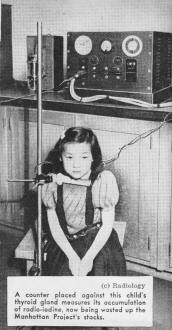
A Geiger counter placed against this child's thyroid gland measures
its accumulation of radio-iodine, now being wasted up the Manhattan Project's stocks.
(c) Radiology
Another practical application of the tagging technique has clarified the failure
of some diabetics to respond to insulin.2 It was known that this was
caused by failure to absorb the drug quickly enough after injection, and that in
certain cases this was due to the practice of injecting repeatedly in the same areas.
Pads of scar tissue and fat developed under the skin at these points, making the
injection painless and encouraging the patient to continue using that same spot.
But the pads also retarded the absorption of the drug. Exactly how much was determined
by marking a 3/4-inch mercurochrome ring on the skin, in the center of which a standard
injection of insulin, tagged with radio-iodine, was made. The Geiger-Muller counter
was then placed over the marked ring and the count recorded; this was repeated at
intervals of 20 minutes, one hour, and two, four, and eight hours. Thus the rate
at which the insulin left the injection site was accurately measured. It was found
that after two hours, instead of absorbing 40 percent of the insulin, one patient
had absorbed only 10 percent. Of course he was not getting enough insulin, and his
sugar content rose accordingly. These tests showed that the advice given to diabetics
to rotate areas of injection so that a given site is not used more than once a month
is no mere flight of the physician's fancy.
Another example of the use of the tracer technique3 goes back to the
Prohibition era. Many thirsty midwesterners tried an alcoholic extract of ginger,
which the Prohibition Bureau had optimistically ruled to be nonpotable. An epidemic
of paralysis of the extremities, especially the feet, broke out among the consumers,
and public health authorities were faced with a serious problem. Several months
of intensive investigation revealed that some of the ginger extract had been adulterated
with about two percent of a phenol compound known as triorthocresyl phosphate -
TCP - the toxic qualities of which had up to then been entirely unsuspected.
In a special laundry where the laboratory clothes of people working on radioactive
substances were decontaminated, the instruments above measured radiations that might
be coming from the clothes both before and after they were laundered.
The film badge (left) was a good check against pocket ionization chambers. Workers
regularly exposed to radiation in atomic-bomb plants had to wear both. All the film
except for a small window was covered by a thin metal shield. Radiation that passed
through the paper protecting the film in the window clouded the film's emulsion.
In the 1940s this same drug began to assume industrial importance, and the question
arose as to how it would affect workmen who handled it in the processing plants.
Specifically, how much of it would they absorb through the skin of their hands?
The radioactive tracer technique was employed. Experimenters applied small quantities
of TCP, labeled with radioactive phosphorus, to the palms of their hands. Blood
and urine samples then were tested for radioactivity and the amount of the drug
absorbed was calculated. Very appreciable quantities rapidly entered the blood stream.
Consequently there was serious danger that workmen handling the stuff routinely,
without precautions, would develop "ginger paralysis." Animal experimentation confirmed
this conclusion. Processing methods were accordingly modified to prevent skin contact.
More recently, studies of the healing of bone, made on rats, have been reported.4
The animals were anesthetized and length-wise cuts made in their leg bones with
a small circular saw. During recovery they were fed radiostrontium and radiophosphorus,
and the uptake of these substances by the healing cut was measured with a Geiger
counter. The results indicated that the time required to reach a maximum uptake
might be used as a measure of healing. Presumably this could lead to evaluation
of the mending of fractures in human subjects.
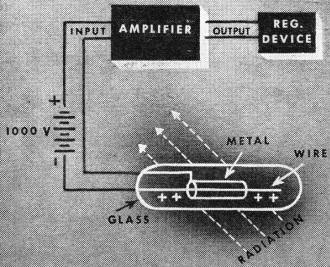
Diagram of a Geiger counter, highly sensitive detector of radiation.
A single charged particle, entering the gas-filled tube, can be recorded.
About half a million Americans suffer from epileptic seizures of varying intensity.
The causes of this disease are still largely obscure. The psychological make-up
of the epileptic has been studied, and comparisons have been made between the electrical
waves of the brains of normal subjects and those that characterize epilepsy. Now
the metabolism of the brain is being studied by means of radioactive sodium and
potassium used as tracers-in the hope that the biochemical basis of epilepsy may
be discovered.5
Tracer technique, however, is not the only contribution of nuclear physics to
medical research. There is also the direct radiation from the cyclotron and ether
nuclear transformers, which may prove preferable in the treatment of some cancers
to the older types of radiation generators, such as the X-ray tube and radium. To
make this possible it is first necessary to collimate the output of the newer devices,
to project the particles in a beam that can be directed on a particular region of
the body. But control of the radiation is only a beginning. It is equally necessary
to know how much can be used safely, i.e., to standardize dosages. In some instances
the answers are known; others are still in the stage of animal experimentation.
One method is to cultivate malignant tumors in mice, expose fragments to definite
quantities of radiation about which information is sought, transplant the fragments
to healthy mice, and compare the proportion of resulting "takes" with similar tumor
sections exposed to X-radiation. It takes thousands of tests of this sort before
application to human beings can be thought of.
These are only a few samples of the work being done. Artificially produced isotopes
have been available less than 12 years. Soon after the investigators developed their
techniques and the materials began to be available in practical quantities, the
war broke out and long-term medical research took a back seat for four years. E.
O. Lawrence tore apart his biggest cyclotron, then under construction; the electromagnet
was needed in the atomic-bomb project. The older cyclotron, in which a good part
of the isotopes used in medical research had been produced, was also turned over
to the Manhattan District. Most of the nuclear physicists went with the equipment,
and many of the research teams of physicists and physicians were broken up just
when they were beginning to get results. It was all necessary and inevitable, but
it was a setback.
Yet it may have been bread cast upon the waters. Those same four years produced
not only the atomic bomb, but a prodigious amount of know-how and equipment directly
applicable to medical research. At one leap we have moved from the age of scarcity
in radioactive materials to the age of plenty. In the production of neutrons one
chain-reacting pile is said to be the equivalent of a million cyclotrons, and a
good-sized cyclotron is the equivalent, for some therapeutic purposes, of about
two pounds of radium, or the entire world stock in 1940.
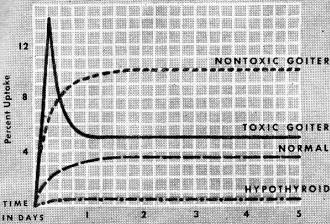
Chart shows the speed and degree with which thyroid glands in
various condition absorb radio-iodine. Sharp peak marks impact on toxic goiter.
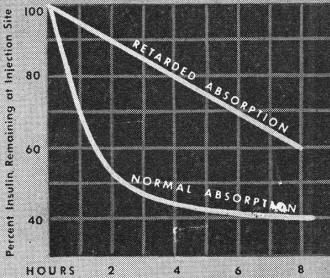
Counter record of how two diabetics responded to radioactive
insulin. Top line shows how absorption was retarded by fat at the injection point.
"Controlled nuclear energy has become a reality," declared Dr. Andrew H. Dowdy,
associate professor of radiology and director of atomic medical research at the
University of Rochester, in a recent speech. "And with this reality a new era has
been born. There is no turning back. The responsibility rests largely in the hands
of the American people, but it is a responsibility that must be shared by the other
nations. The hazards are admittedly great, but the benefits are so tremendous as
to stagger the imagination."
Although we now have, potentially, more radiation than we can use, we still lack
trained men - and money. Here, in the greatest and richest country in the world,
scientists in charge of research projects concerned with matters of life and death
still have no alternative but to run from one foundation to another, raising $1,000
here and $500 there, instead of spending their time in their laboratories. But if
we prove capable of an intelligent appreciation of the vital importance of research,
scientific medicine is sure to make great strides in the understanding of its subject
matter, and, eventually, in the conquest of disease.
Early this year, the editors of this magazine initiated an investigation into
atomic medicine as one of the first and perhaps most valuable by-products of the
two-billion-dollar Manhattan Project. We knew that man's ills and pains are not
popular unless they are personal. We knew that to get and to print the story would
be difficult. But we also knew that the story had to be told, not only for itself,
but as a test of the availability of all the vital and valuable non-military information
the scientist's searches and the people's money had purchased.
We assigned an able writer, Carl Dreher, whose own military experience made him
very conscientious about military security. He researched and wrote a rounded and
stimulating story. This was shown to some 40 scientific and medical people for their
opinion. Their approval of the need and the article was gratifying.
To illustrate the article we could hardly send our own photographers into the
secret reaches of Oak Ridge, so we asked the Army to furnish pictures of the non-secret
protective devices used in the atomic-bomb plants and freely described in the Smyth
Report and the public prints. The photographs were taken and sent to Washington
for clearance. At this point General Leslie Richard Groves said, "No." No pictures.
no pictures of any kind.
That is why there are blank spaces on page 93. More important, it is why there
are blank spaces in the record of medical research. And why radio-iodine, for instance,
goes smoking up the stacks of the Manhattan Project plants while thyroid cancer
patients cost $10,000 to treat.
Ours is only one of the many cases against General Groves. he has larger charges
to answer. In the name of military security, he has discouraged every effort to
apply the lessons of atomic research to the improvement of the civilian economy.
He has blocked every move toward civilian control of atomic processes. And, in his
own public testimony, he has convicted himself of a social stupidity that is outstanding
even in a military man.
Yet, essentially, our quarrel is not with General Groves but with the generals
- with the rubber-stamp minds that cannot, as a result of their leaning and training,
answer an all-embracing question with a creative "Yes." We do not advocate that
the hard-bought secrets of the atomic bomb be handed to Russia - or Iran. We do
not condone treachery in Canada. But neither do we believe that the generals are
fit custodians of science. Nothing so big should be controlled by anything less
than the total of the people.
Certainly science cannot long endure its present state of arrest.
1 Radiology, 35:174, August, 1940.
2 Journal of the American Medical Association, Jan. 8, 1944.
3 Given by Drs. Harold C. Hodge and James H. Sterner, of the University of Rochester,
in Journal of Pharmacology and Experimental Therapeutics, November, 1943.
4 By Drs. Alfred Marshak and R. L. Byron in Journal of Bone and Joint Surgery,
January, 1945.
5 This work is being carried on at the University of California Medical School.
Posted November 14, 2023
|


















